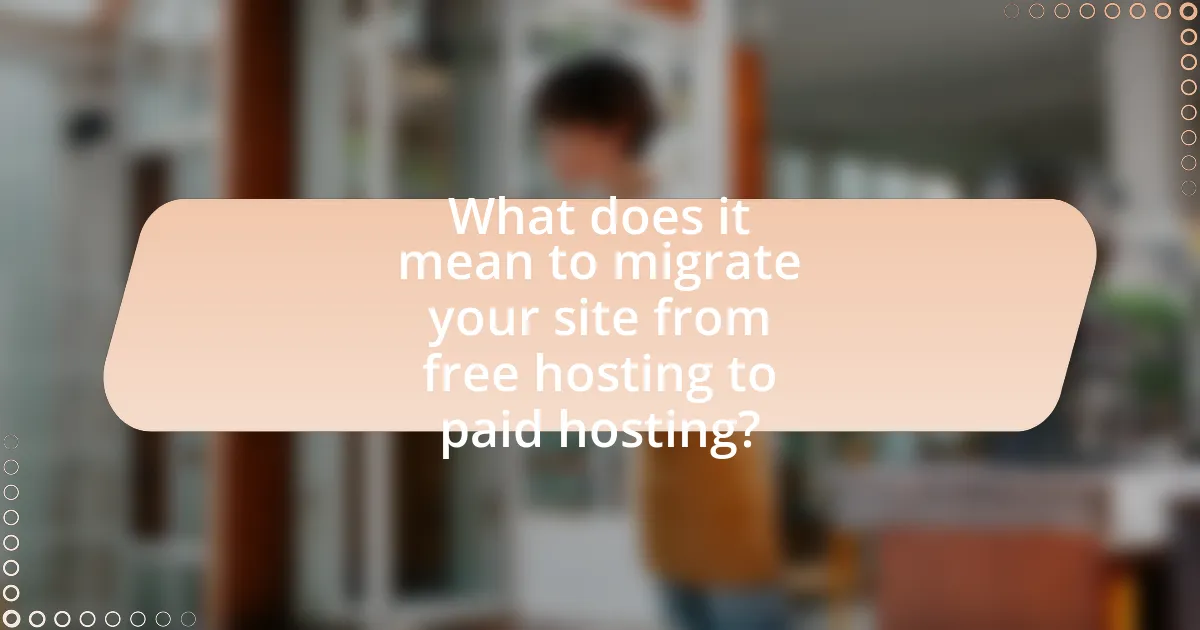Migrating your site from free hosting to paid hosting involves transferring website files, databases, and configurations to a more robust hosting provider. This process enhances website performance, security, and support, addressing the limitations of free hosting services, such as slow speeds and minimal customer assistance. Key steps in the migration include planning, backing up data, selecting a new provider, transferring files, updating DNS settings, and testing the new site. Essential considerations for choosing a paid hosting provider include reliability, performance, customer support, and scalability options, while best practices during migration ensure a smooth transition and minimize downtime.

What does it mean to migrate your site from free hosting to paid hosting?
Migrating your site from free hosting to paid hosting means transferring your website’s files, databases, and configurations from a free hosting service to a paid hosting provider. This process typically involves selecting a paid hosting plan, backing up your website data, uploading it to the new server, and updating domain settings to point to the new host. Paid hosting often offers enhanced features such as better performance, increased storage, and improved security, which are not typically available with free hosting services.
Why should you consider migrating from free hosting?
Migrating from free hosting is advisable due to limitations in performance, reliability, and support. Free hosting often results in slower website speeds, which can negatively impact user experience and SEO rankings. According to a study by Google, a one-second delay in page load time can lead to a 20% decrease in traffic. Additionally, free hosting services typically offer minimal customer support, leaving users without assistance during critical issues. Security is another concern, as free hosting providers may lack robust security measures, making websites more vulnerable to attacks. Therefore, transitioning to a paid hosting service enhances website performance, security, and support, ultimately leading to a better online presence.
What are the limitations of free hosting services?
Free hosting services have several limitations, including restricted bandwidth, limited storage space, lack of customer support, and the presence of advertisements. These constraints can hinder website performance and user experience, as many free hosting providers impose strict data transfer limits, which can lead to slow loading times or downtime during peak traffic. Additionally, free hosting often offers minimal storage capacity, making it challenging for users to host larger websites or applications. The absence of reliable customer support can leave users without assistance during critical issues, while mandatory advertisements can detract from the site’s professionalism and user engagement.
How can paid hosting improve your website’s performance?
Paid hosting can significantly improve your website’s performance by providing faster loading speeds, enhanced security, and better uptime reliability. Faster loading speeds are achieved through dedicated resources and optimized server configurations, which can reduce page load times by up to 50%, as reported by various web performance studies. Enhanced security features, such as SSL certificates and regular backups, protect against data breaches and downtime, ensuring a safer user experience. Additionally, paid hosting services typically offer higher uptime guarantees, often exceeding 99.9%, which minimizes the risk of your website being inaccessible to users. These factors collectively contribute to a more efficient and reliable website, ultimately improving user satisfaction and engagement.
What are the key steps involved in the migration process?
The key steps involved in the migration process from free hosting to paid hosting include planning, backing up data, choosing a new hosting provider, transferring files, updating DNS settings, and testing the new site.
Planning involves assessing the current site and determining the requirements for the new hosting environment. Backing up data ensures that all website files, databases, and configurations are securely saved before migration. Choosing a new hosting provider requires evaluating options based on performance, support, and pricing. Transferring files includes uploading the backed-up data to the new server using FTP or a control panel. Updating DNS settings is necessary to point the domain to the new hosting provider, which may take some time to propagate. Finally, testing the new site ensures that all functionalities work correctly and that the migration was successful.
How do you prepare your site for migration?
To prepare your site for migration, first conduct a comprehensive backup of all website files and databases. This ensures that you have a complete copy of your site in case any issues arise during the migration process. Additionally, assess your current hosting environment to identify any specific configurations or settings that need to be replicated on the new paid hosting platform. It is also essential to update your domain’s DNS settings to point to the new hosting provider once the migration is complete. According to a study by SiteGround, 70% of migration issues stem from inadequate backups and misconfigured settings, highlighting the importance of thorough preparation.
What tools can assist in the migration process?
Tools that can assist in the migration process include website migration plugins, FTP clients, and backup solutions. Website migration plugins, such as Duplicator and All-in-One WP Migration, streamline the transfer of files and databases from one host to another. FTP clients like FileZilla facilitate the transfer of files directly between the local system and the server. Backup solutions, such as UpdraftPlus, ensure that all site data is securely saved before migration, minimizing the risk of data loss. These tools are widely used and recommended for their effectiveness in simplifying the migration process.

What should you look for in a paid hosting provider?
When selecting a paid hosting provider, prioritize reliability, performance, and customer support. Reliability ensures your website remains accessible, with uptime guarantees typically above 99.9%. Performance is crucial, as faster loading times enhance user experience and SEO rankings; look for providers that offer SSD storage and optimized server configurations. Customer support should be responsive and available 24/7, as timely assistance can resolve issues quickly. Additionally, consider scalability options to accommodate future growth, as well as security features like SSL certificates and regular backups to protect your data.
How do you evaluate different hosting plans?
To evaluate different hosting plans, compare key factors such as performance, scalability, support, and pricing. Performance metrics include uptime guarantees and server speed, which are critical for ensuring your website runs smoothly. Scalability options allow your hosting plan to grow with your website’s traffic, ensuring you can upgrade resources as needed. Support quality is essential; look for 24/7 customer service and multiple contact methods. Pricing should be transparent, with no hidden fees, and should align with the features offered. According to a 2021 survey by HostingAdvice, 70% of users prioritize uptime and support when selecting a hosting provider, highlighting the importance of these factors in your evaluation.
What features are essential in a paid hosting plan?
Essential features in a paid hosting plan include reliable uptime, sufficient storage and bandwidth, robust security measures, customer support, and scalability options. Reliable uptime ensures that websites remain accessible, typically aiming for 99.9% availability. Sufficient storage and bandwidth accommodate website growth and traffic demands. Robust security measures, such as SSL certificates and regular backups, protect against data breaches. Customer support provides assistance through various channels, ensuring timely resolution of issues. Scalability options allow users to upgrade resources as their website grows, making the hosting plan adaptable to changing needs.
How does customer support impact your hosting choice?
Customer support significantly impacts hosting choice by influencing user experience and problem resolution efficiency. Reliable customer support ensures that users can quickly address technical issues, which is crucial during the migration from free to paid hosting, where complexities often arise. According to a survey by the International Data Corporation, 70% of customers cite effective support as a key factor in their hosting provider selection. This statistic underscores the importance of responsive and knowledgeable support teams in maintaining uptime and user satisfaction, ultimately guiding users toward their hosting decisions.
What are the costs associated with paid hosting?
The costs associated with paid hosting typically include monthly or annual subscription fees, which can range from $3 to $500 depending on the hosting plan and provider. Additional costs may involve domain registration fees, which average around $10 to $20 per year, and potential charges for extra features such as SSL certificates, backups, and increased storage or bandwidth. For instance, shared hosting plans are generally more affordable, while dedicated servers or managed WordPress hosting can be significantly more expensive, reflecting the level of service and resources provided.
How can you budget for your new hosting expenses?
To budget for your new hosting expenses, first, determine the specific hosting plan that meets your needs, including factors like storage, bandwidth, and support. Next, calculate the total cost by considering both the monthly or annual fees and any additional costs such as domain registration or SSL certificates. For example, if a hosting plan costs $10 per month and you need a domain for $15 per year, your total annual budget would be $135. Additionally, it is wise to set aside a contingency fund of 10-20% of your total budget to cover unexpected expenses or upgrades. This structured approach ensures that you have a clear financial plan for your hosting needs.
What are the potential hidden costs of paid hosting?
The potential hidden costs of paid hosting include additional fees for features such as backups, security, and technical support. Many hosting providers advertise low initial prices but may charge extra for essential services like SSL certificates, domain registration, and email accounts. For instance, a study by HostingAdvice found that 70% of users experienced unexpected charges related to add-ons or upgrades. Additionally, costs can arise from exceeding bandwidth limits or storage quotas, which can lead to overage fees. Understanding these potential expenses is crucial for accurately budgeting for paid hosting.

How do you execute the migration from free to paid hosting?
To execute the migration from free to paid hosting, first, select a suitable paid hosting provider that meets your website’s needs. After choosing the provider, back up your website files and database from the free hosting platform. Next, upload these files and import the database to the new paid hosting account using an FTP client and a database management tool like phpMyAdmin. Finally, update your domain’s DNS settings to point to the new hosting server, ensuring that the changes propagate correctly. This process is validated by the standard practices in web hosting migration, which emphasize the importance of backups and DNS updates for a seamless transition.
What are the technical steps to migrate your website?
To migrate your website from free hosting to paid hosting, follow these technical steps: First, back up your website files and database from the free hosting provider. Use an FTP client to download all files and export the database using tools like phpMyAdmin. Next, purchase a paid hosting plan and set up your domain name. After that, upload your website files to the new hosting server using the FTP client and import the database into the new server’s database management system. Update the configuration files to reflect the new database credentials and paths. Finally, test the website on the new server to ensure everything functions correctly before updating the DNS settings to point to the new hosting provider. These steps ensure a smooth transition with minimal downtime.
How do you back up your website before migration?
To back up your website before migration, use a combination of file and database backups. First, access your website’s files via FTP or your hosting control panel and download all files to your local computer. This includes HTML, CSS, JavaScript, images, and any other media. Next, back up your database by exporting it through tools like phpMyAdmin, which allows you to create a .sql file of your database. This dual approach ensures that both your website’s content and its underlying data are preserved. According to industry best practices, maintaining both file and database backups minimizes the risk of data loss during the migration process.
What is the process for transferring your domain name?
To transfer your domain name, you must first unlock the domain at your current registrar and obtain the authorization code. Next, initiate the transfer process with your new registrar by providing the authorization code and confirming the transfer request. The current registrar will then send a transfer approval email, which you must accept to complete the process. This method is standard across most registrars, ensuring a secure and verified transfer of ownership.
What common issues might arise during migration?
Common issues that might arise during migration include data loss, downtime, and compatibility problems. Data loss can occur if backups are not properly created or if files are corrupted during the transfer process. Downtime may happen due to DNS propagation delays or server configuration errors, which can lead to accessibility issues for users. Compatibility problems can arise when the new hosting environment differs significantly from the previous one, potentially causing website functionality issues. These challenges are frequently reported by users migrating from free to paid hosting, emphasizing the importance of thorough planning and testing before and after the migration process.
How can you troubleshoot website downtime during migration?
To troubleshoot website downtime during migration, first check DNS settings to ensure they point to the new server correctly. Incorrect DNS configurations can lead to downtime, as users may still be directed to the old server. Next, verify that all files and databases have been transferred successfully to the new hosting environment, as incomplete migrations can cause site inaccessibility. Additionally, monitor server performance and error logs for any issues that may arise during the migration process, as these logs can provide insights into specific problems affecting uptime. Finally, consider implementing a temporary maintenance page to inform users of the migration, which can help manage user expectations during the transition.
What should you do if your site doesn’t function properly after migration?
If your site doesn’t function properly after migration, first, check the server configuration settings to ensure they match the requirements of your site. Misconfigurations can lead to issues such as broken links or missing files. Next, verify that all files were transferred correctly; incomplete transfers can cause functionality problems. Additionally, review the database connection settings, as incorrect credentials can prevent your site from accessing necessary data. Finally, consult error logs for specific issues that can guide troubleshooting. These steps are essential because many migration problems stem from configuration errors or incomplete data transfers, which are common during the migration process.
What best practices should you follow during the migration process?
During the migration process from free hosting to paid hosting, it is essential to create a comprehensive backup of your website data, including files and databases. This practice ensures that you have a complete copy of your site in case of any issues during the migration. Additionally, testing the new hosting environment before the final switch is crucial; this allows you to identify and resolve potential problems without affecting the live site. Furthermore, updating DNS settings carefully and monitoring the site post-migration for any errors or downtime is vital to ensure a smooth transition. These practices are supported by industry standards, which emphasize the importance of data integrity and minimal downtime during migrations.
How can you ensure a smooth transition to paid hosting?
To ensure a smooth transition to paid hosting, first, back up all website data, including files and databases. This step is crucial as it prevents data loss during the migration process. Next, choose a reliable paid hosting provider that meets your website’s needs, such as bandwidth and storage requirements. After selecting the provider, set up the new hosting account and upload the backed-up data to the new server. Finally, update the domain’s DNS settings to point to the new hosting provider, ensuring that the changes propagate correctly. According to a study by HostingAdvice, 70% of website downtime during migration is due to improper DNS configuration, highlighting the importance of this final step for a seamless transition.
What post-migration checks should you perform to verify success?
To verify the success of a site migration from free hosting to paid hosting, perform checks such as verifying website functionality, ensuring data integrity, checking DNS propagation, and monitoring site performance. Verifying website functionality involves testing all links, forms, and interactive elements to confirm they work as intended. Ensuring data integrity requires checking that all files, databases, and content have been accurately transferred without loss. Checking DNS propagation involves confirming that the domain points to the new hosting server, which can be validated using tools like DNS checkers. Monitoring site performance includes assessing load times and responsiveness to ensure they meet or exceed previous benchmarks. These checks are essential to confirm that the migration was successful and that the site operates correctly in its new environment.